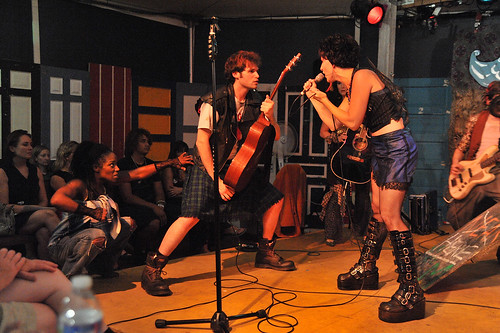
Now, as a storyteller, I'd certainly heard of Fionn mac Cumhaill (my Celtic storytelling colleagues would never forgive me if I didn't use the Gaelic spelling). Over the years, I had heard a tale here or there of this Irish warrior-king of the Fianna, but I'd never read or heard Finn's origin story (And, truth be told, hearing one too many versions of the tall tale where Finn meets Cuchulainn did not inspire me to seek it out). So now here, I hoped, in DC, I'd get to hear it... gathered in the darkness with strangers to hear a story.
Only we weren't gathered in the dark. We were in a portable tent (a good omen for storytelling) set up as a temporary venue constructed for the duration of the Fringe, with a massive soundsystem (so it could double as the party spot) and a roof to keep the summer thundershowers off the outdoor thrust stage (seating on three sides). Though not air-conditioned (and in DC in July, that fact made it into every review of each show that played there), the venue was conveniently located next to the Fringe bar.
The stacks of amps, full drum kit, microphones, and numerous electric guitars on the stage made me realize this was not going to be your average storytelling set. The programs and postcards for the show set up the frame that the legend of Finn McCool would be presented as a rock and roll revue with six bands on the bill (With just 8 performers in the show, the "bands" were created with costume changes and sometimes switching up instruments).
And so, in music and song, we were treated to Finn's origin story: how his father, leader of the Fianna warriors, was killed by Goll Mac Morna; how his mother gave him up to be raised in secret by the druidess Bodhmall and the warrior woman Liath Luachra; and how Finn obtains the Salmon of Wisdom during his service to the poet and teacher Finneces, which enables him to claim his place as leader of the Fianna and defeat Goll.
Plot points were kept to a minimum to let the music do the heavy lifting of the show: and it worked. The music ranged from ballads (both acoustic and power) to art rock to stadium rock to blues... the troupe used a wide musical palette to vary the emotions through the arc of the story, and the audience cheered every time they recognized a trope (e.g. guitar solos, power duets, drinking song choruses). I was also impressed by the quality of the performers (though the show had a thrown-together, held-together-with-duct-tape thrift-store aesthetic, everyone in it, from the costumer to the composer to the performers had bona fide professional theatre chops). The singers--most with musical theatre backgrounds and many recognized by local critics and peers with theater awards--really delivered, as the variety of songs explored a vast emotional range.

Pictured: Audience and Felicia Curry, Matthew Schleigh (as Finn), and Debra Buonaccorsi. Photo copyright 2010 by Paul Gillis Photography; used by permission
This show called to mind ancient traditions of epic storytelling, where the community gathered to listen to stories of heroes, and achieve an altered state of consciousness. At the Fringe, our consciousness was being altered not only by our willingngess to engage with the drama, but the soaring melodies and the volume of the music, but by the venue's heat, humidity, and proximity to the performers (no one was farther than 15 feet from the stage). The availability of alcohol helped, too.
Furthermore, the posturing and tropes of rock and roll passed for modern day versions of the ritual required for the sharing of such epics. So, while in an oral culture, everyone in the audience would know the story (e.g. the Ramayana) , this performance gave the audience a story in a style everyone knew, though many weren't familiar with the characters or plot.
The creators of the show made sure that before and after each song, characters explained who they were, what they wanted, and where they were going. The extra exposition here was necessary for an audience unfamiliar with this epic. Some reviewers complained that the exposition muddied the dramatic arc, but I found it was not only necessary to get the story out, but actually a clever way to continue to build the trance state you want in an epic storytelling session (My own theory: by giving the logical brain narrative, we're compelled to engage more--to find out what happens next-- which allows us to continue in the performance environment towards a trance state).
Me? I’m predisposed to enjoying epic narration (my list of most enjoyable theatrical experiences include narration heavy shows like lookingglass theatre’s Argonautika and Metamorphoses, and Mabou Mines’ Peter and Wendy… and to which, I’m adding this production), so my enthusiasm for this show might differ from the typical DC theatregoer, but all in all... I found it a thoroughly delightful way to engage with an ancient myth, and in terms of artistic craft, an inventive and masterfully crafted performance experience.
If you're not in the DC area (and won't get a chance to see future productions of Finn McCool), you can get a mere taste of it: Check out this Flickr slide show with Paul Gillis' photos (link) while you play music from the show via DMLRR's page on Myspace. (The versions there are clean, but nowhere near as thrilling as hearing them performed live by sweaty rock and rollers a stone's throw from you!)
Coming up soon: an interview with one of the show's creators, Debra Buonaccorsi
1 comment:
FYI, I've learned that Dizzy Miss Lizzie's Roadside Revue will present Finn McCool again in Washington DC in March 2011 at the Wooly Mammoth Rehearsal Hall... with your help. Check out the show's Kickstarter campaign here.
Post a Comment